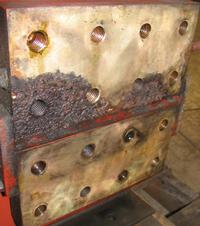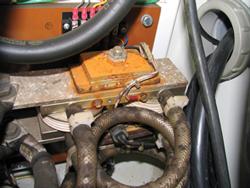Chairman
- FMA
- The Fabricator
- FABTECH
- Canadian Metalworking
Categories
- Additive Manufacturing
- Aluminum Welding
- Arc Welding
- Assembly and Joining
- Automation and Robotics
- Bending and Forming
- Consumables
- Cutting and Weld Prep
- Electric Vehicles
- En Español
- Finishing
- Hydroforming
- Laser Cutting
- Laser Welding
- Machining
- Manufacturing Software
- Materials Handling
- Metals/Materials
- Oxyfuel Cutting
- Plasma Cutting
- Power Tools
- Punching and Other Holemaking
- Roll Forming
- Safety
- Sawing
- Shearing
- Shop Management
- Testing and Measuring
- Tube and Pipe Fabrication
- Tube and Pipe Production
- Waterjet Cutting
Industry Directory
Webcasts
Podcasts
FAB 40
Advertise
Subscribe
Account Login
Search
Respecting resistance welders
Avoiding downtime with preventive maintenance practices
- By Tom Snow
- Updated August 10, 2023
- March 11, 2008
- Article
- Shop Management

Figure 1The secondary circuit of this resistance welding machine that arced out because of loose bolts had to be machined.
Resistance welding machines are the Rodney Dangerfields of the welding world—they don't get no respect.
Since the resistance welding (RW) process is not widely understood, machines themselves typically are understood even less. However, if RW parts are rejected because of poor weld strength, or if the machine quits altogether, a crisis often results. Suddenly all eyes turn toward the lowly, often-ignored welding machine, which may not have had any preventive maintenance for years.
Although RW equipment looks deceptively simple and maintenance-free, several systems and components need to undergo maintenance once a year. Quality resistance welds are the result of the machine's electrical, mechanical, pneumatic, and water-cooling systems working together properly. A problem with any one of these systems can mean machine breakdowns or poor-quality welds.
Maintaining the Electrical Systems of Resistance Welders
RW is a high-speed method of joining metals by using pressure and electric heating under accurate control. The machine applies high forging force, and unlike most arc welding processes, no additional material is added. The machine's transformer converts high incoming voltage and low primary amps into high secondary amps and low secondary volts. As an example, a typical RW transformer might convert 200 amps of incoming power into 20,000 secondary amps.
At the same time, the transformer converts line voltage (220 or 440 volts) into very low secondary voltage, typically less than 10 V. That's why you can touch the secondary of an RW machine during the welding process and not get shocked, even though thousands of amps are being produced.
However, this also means that the machine's secondary circuit is prone to problems caused by loose connections, oxidation, dirt, grease, and other contamination that can serve as unwanted electrical insulation. As the secondary circuit deteriorates, the output of the machine is reduced. Once deterioration starts, it feeds on itself and accelerates, because of increased resistance and heat.
A proper preventive maintenance program should include disassembling all mating copper, low-voltage, secondary electrical connections for cleaning and buffing on a regular basis. Machining is often required if connections have worked loose and arced (see Figure 1).
In the ideal world, all secondary connections would be silver-plated for enhanced conductivity, but that's neither practical nor cost-effective in most applications. As an alternative, consider coating the mating surfaces with a layer of Cool-Amp silver-plating powder, which can be applied by hand and will significantly reduce contact resistance in the joint. Make sure all bolts used in the secondary connections are nonmagnetic, such as brass, and are tightened securely and evenly.
Keep Pneumatics Running Smoothly
Consistent application of the proper forging force for the material being welded is required for good weld quality. Although there is a growing trend toward electric servo-actuated resistance welders, most machines in use today are air-operated. Moisture is the most common problem found in RW pneumatic systems, and compressors connected to air-operated machines should have an air drier installed.
In addition, each machine should have an air filter, regulator, and (if required) a lubricator installed. Preventive maintenance should include looking inside the air cylinder once a year and rebuilding it as required, with new packing and seals. If the cylinder has sat idle with moisture inside for any length of time, cylinder walls and shafts may need to be polished or replaced because of pitting.

Figure 2The water chiller on this unit was set well below the dew point. As a result, the SCR contactors rusted and mold formed on the water hoses.
If the cylinder is not permanently lubricated and a lubricator (oiler) is installed, be sure that it's set properly, with approximately one drop of oil per 10 to 15 strokes of the machine. Most lubricators are set too high, resulting in the machine's air exhaust mufflers, if installed, clogging with oil and constricting the flow of air exiting the cylinder. In addition to making a mess, this can hinder the proper application of weld force and reduce weld quality.
Electric servo-actuated force delivery systems are starting to replace air cylinders on RW machines due to their accuracy and performance. Also, they are more environmentally friendly because they do not emit oil mist.
Resistance Welders Water Cooling and Condensation
Water cooling is an often-overlooked factor in the proper operation of resistance welders. As copper gets hot it loses some of its conductivity, resulting in reduced output. For proper operation in a production line environment, an RW machine should be supplied with an adequate flow of water, about 2 to 3 gallons per minute (GPM), and at the proper temperature, usually 68 to 70 degrees F. Also, it is critical that the water-cooling circuits are properly installed and maintained.
If a machine has one water circuit with all components plumbed in series, it may run hot. Multiple parallel water circuits branching off an incoming water distribution manifold, with flow indicators and flow adjustment valves for each circuit, are recommended.
If city water is used to cool a resistance welder, mineral deposits and sludge may gradually build up in the water-cooling lines, constricting flow. Unfiltered well water often is even worse. The water cooling lines can be flushed with diluted vinegar or an industrial cleaning solution, but you should avoid anything that's caustic, because it may attack the transformer's internal copper water tubes.
Use properly sized, self-contained, recirculating water chillers to cool the RW equipment. Since each welder typically needs several gallons of water per minute to run cool at production line speeds, chillers can pay for themselves quickly. However, while chillers can extend electrode life and solve the problem of high water cost and water's questionable quality and availability, chillers can also create expensive maintenance problems because of condensation. Although condensation can be a good thing on a glass of ice water or a cold beer, it's bad for a resistance welding machine.
It is important to set the chiller's water temperature above the dew point each season, particularly during summer months. To prevent possible condensation inside the control and welding transformer, it is advisable to turn the water chiller off whenever the machine will not be operated.
Hot temperatures and high humidity levels during the past few summers have made condensation more problematic than ever. Transformers that are soaked internally with condensation for extended periods of time can cause the unit to short out and blow in dramatic fashion (see Figure 2). Most RW transformers can be baked-out or rewound, but typically not overnight.
Updating Controls for Resistance Welders
Electronic controls used on RW units have come a long way in the last 15 to 20 years. Many of the older, now obsolete controls did not include functions that can help improve the RW process, such as upslope, pulsation, and automatic voltage compensation (AVC). If the control is obsolete, consider replacing it with one of the modern programmable types.
When working on a control, especially if a water-cooled SCR contactor has been replaced, it is important to remember that all rubber water hoses inside the cabinet connected to the machine's high-voltage contactor must be at least 18 inches long and made of nonconductive material. Beware of using a rubber hose that contains metal braid or is black inside, which may indicate high carbon content and the ability to conduct some current.

Figure 3The SCR contactor on this control failed because of overheating. Notice the mineral deposits inside the water lines.
If line voltage to the control is left on and the water flow is stopped, water inside this hose may eventually boil and produce superheated steam. This can melt the hose and flood the inside of the control (seeFigure 3). Good housekeeping practices should be applied to controls, with the inside kept clean and oil-free.
Resistance Welders Machine Rebuild
The ultimate RW preventive maintenance project is to completely strip and rebuild the machine to a like-new condition. Although it's a major job, any competent maintenance mechanic should be able to accomplish a rebuild.
Older machines typically are built heavier than many of the new machines on the market today, making a rebuild worthwhile and cost-effective. In the past most RW machines manufactured and sold in the U.S. met standards published by the Resistance Welding Manufacturing Alliance (RWMA). The copper secondary circuits of these older machines built to RWMA specifications were designed to deliver high welding currents more efficiently than some of the imports that are sold today, many of which have secondary conductors made of brass. Other RWMA standards address duty cycle and weld force specifications.
When a machine is down for rebuild is a good time to consider replacing the machine's electronic control, if it is obsolete, because OEMs no longer support many models.
The old adage of being careful to have no parts left over applies to RW rebuilds, too, since the thin sheets of electrical insulation used to isolate one side of the unit's secondary circuit are often overlooked and not reinstalled, causing high welding current to pass through the frame of the machine. This will eventually cause machine components, such as slides and bearings, to arc and fail.
Since strong resistance welds are critical to so many products, it's surprising that most RW machines don't get the respect and attention they deserve. However, properly maintained equipment will produce quality welds for decades.
About the Author
About the Publication
subscribe now

The Welder, formerly known as Practical Welding Today, is a showcase of the real people who make the products we use and work with every day. This magazine has served the welding community in North America well for more than 20 years.
start your free subscription- Stay connected from anywhere

Easily access valuable industry resources now with full access to the digital edition of The Fabricator.

Easily access valuable industry resources now with full access to the digital edition of The Welder.

Easily access valuable industry resources now with full access to the digital edition of The Tube and Pipe Journal.
- Podcasting
- Podcast:
- The Fabricator Podcast
- Published:
- 04/16/2024
- Running Time:
- 63:29
In this episode of The Fabricator Podcast, Caleb Chamberlain, co-founder and CEO of OSH Cut, discusses his company’s...
- Trending Articles
Sheffield Forgemasters makes global leap in welding technology

Welding student from Utah to represent the U.S. at WorldSkills 2024

Lincoln Electric announces executive appointments

Engine-driven welding machines include integrated air compressors

ESAB unveils Texas facility renovation

- Industry Events
16th Annual Safety Conference
- April 30 - May 1, 2024
- Elgin,
Pipe and Tube Conference
- May 21 - 22, 2024
- Omaha, NE
World-Class Roll Forming Workshop
- June 5 - 6, 2024
- Louisville, KY
Advanced Laser Application Workshop
- June 25 - 27, 2024
- Novi, MI


























